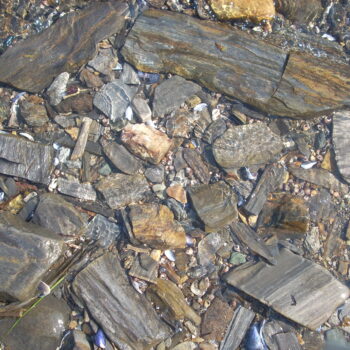
Poised on the Edge of Order and Chaos
[Derived from William Bergquist and Agnes Mura, Ten Themes and Variations for Postmodern Leaders and Their Coaches.]
Theme: Acknowledging the Role of Chaos in Our Postmodern World
Fundamental Question
What might we learn from postmodern theorists, observers and critics as well as contemporary physicists and biologists about the nature of change as it is now occurring in 21st Century societies?
In a 1991 article in Scientific American that has become a classic in the field, Stuart Kauffman introduces a new concept of chaos and order. He describes three different categories or states in which many systems can be placed. One of these states is highly ordered and structured. Kauffman draws an analogy between this state and the solid state that water takes when it is frozen. A second state is highly chaotic. Kauffman equates this state with the gaseous form which water takes when it is evaporating. The third (most interesting) state is one of transition between order and chaos, which Kauffman equates with the liquid state of water. The differentiation between solid, gaseous and liquid networks can be of significant value in setting the context for any discussion of postmodernism in organizations—and, in particular, the irreversibility of many organizational processes. We must look not only at ordered networks—the so-called solid state—and at chaotic networks—the so-called gaseous state—but also at liquid networks that hover on the brink of chaos, if we are to understand and influence our unique postmodern institutions.
The third (liquid) state holds great potential when we examine and seek to understand confusing and often elusive organizational phenomena such as intentions, leadership and communication. Turbulent rivers, avalanches, shifting weather patterns, and other conditions that move between order and chaos typify the liquid state. Liquid systems contain chaotic elements as well as elements of stability. There are both quiet pools and eddies in a turbulent river. Mountain avalanches consist of not only rapidly moving volumes of snow but also stable snow packs on top of which, around which, or onto which the cascading snow moves. Stable and chaotic weather patterns intermingle to form overall climatic patterns on our planet.
The liquid state is one that is filled with edges and shifting boundaries. A liquid, edgy state is also filled with the potential for learning. A liquid system has the capacity to adjust and rework itself into an orderly, solid state. At certain points, however, the solid state (the eddy, the snow pack, or the stable weather pattern) reaches a super-critical state and can no longer adjust to the addition of another change or variant in pattern. At this point the system becomes fluid and an avalanche occurs. Portions of the system take on a very different form, and the system can once again adjust to the addition of a few changes or alterations in pattern. We would suggest that most organizations live on the edge, in the liquid state, poised on the edge of chaos. Furthermore, organizations are dynamic systems that can adjust based on quick and accurate feedback systems. This is first-order change. Yet, at a super-critical stage, organizations can no longer adjust. They can no longer accept any additional change or crisis. The one additional piece of straw has broken the camel’s back. An avalanche begins and the organization changes in a profound manner. This is second-order change.
The theory of self-organizing criticality (or weak chaos) and edginess suggests that small events (first order changes) such as a shift in leadership will usually produce only minor alterations in the structure and dynamics of the organization (the snow pack will get a bit wider or a bit higher). However, a change in leadership sometimes will create a major second-order alteration (an avalanche). Furthermore, while the outcomes are dramatically different, Bak and Chen have proposed that the same processes are involved in the initiation of both the minor and major changes, and that the onset of the major event can not be predicted—in part because the same process brings about both outcomes.
The liquid state and the edge are places of leadership and innovation (“the leading edge”). They are settings where things get done—yet often in the context of a very challenging and exhausting environment (what Peter Vail describes as a white water world). Edges have no substance. They come to a point and then disappear. Perhaps this is what the new postmodern edginess is all about—what Milan Kundera calls “the unbearable lightness of being.” We need to learn how to live and work in this new environment of edges. If this is the case, then perhaps we need to listen to the architects and prophets of postmodernism, for they may provide some valuable clues as to how this world might best be faced. These architects and prophets come in many different forms: deconstructionists, feminists, chaos theorists, structuralists. What they have to say challenges all who seek to increase the effectiveness of contemporary organizations—including those in the profession of organizational coaching.
________________________
Co-Authors
William Bergquist
An international coach and consultant, professor in the fields of psychology, management and public administration, author of more than 45 books, and president of a graduate school of psychology. Dr. Bergquist consults on and writes about personal, group, organizational and societal transitions and transformations. His published work ranges from the personal transitions of men and women in their 50s and the struggles of men and women in recovering from strokes to the experiences of freedom among the men and women of Eastern Europe following the collapse of the Soviet Union. In recent years, Bergquist has focused on the processes of organizational coaching. He is coauthor with Agnes Mura of coachbook, co-founder of the International Journal of Coaching in Organizations and co-founder of the International Consortium for Coaching in Organizations. His graduate school (The Professional School of Psychology: www.psychology.edu) offers Master and Doctoral degrees in both clinical and organizational psychology to mature, accomplished adults.
Agnes Mura
Agnes Mura, MA MCC, forged her approach to people and organizations in different political systems, European universities and a dramatic life of geographic and professional migrations. Her careers as an academic, senior international banker and then executive coach reflects her relentless curiosity for the ways individuals add value in the world, while staying true to their ever-expanding sense of self. Inspired by her studies in philosophy and linguistics, steeped in the human potential
movement as much as in the world of global business, she is among the Master
Certified Coaches (MCC) of longest-standing experience in the US. Fluent in six
languages, she coaches C-suite executives and their teams in Global 1000
companies, and delivers systemic Leadership programs worldwide. Her deep understandin of how people develop through professional (and life) changes, and her proven cultural acumen allow her to also galvanize and empower large audiences to take on new creative action. For over fifteen years, in addition to holding leadership
positions in several national coaching organizations, she has been an Assessor
for the ICF, certifying coaches and accrediting coach training programs
world-wide.
- Posted by Bill Bergquist
- On August 19, 2011
- 0 Comment


Leave Reply